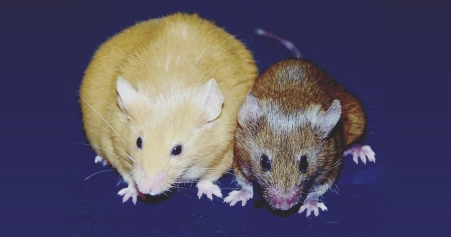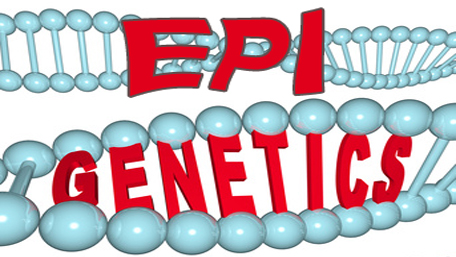Creative Minds: Building the RNA Toolbox

Caption: Genetically identical mice. The Agouti gene is active in the yellow mouse and inactive in the brown mouse.
Credit: Dana Dolinoy, University of Michigan, Ann Arbor, and Randy Jirtle, Duke University, Durham, NC
Credit: Dana Dolinoy, University of Michigan, Ann Arbor, and Randy Jirtle, Duke University, Durham, NC
Step inside the lab of Dana Dolinoy at the University of Michigan, Ann Arbor, and you’re sure to hear conversations that include the rather strange word “agouti” (uh-goo-tee). In this context, it’s a name given to a strain of laboratory mice that arose decades ago from a random mutation in the Agouti gene, which is normally expressed only transiently in hair follicles. The mutation causes the gene to be turned on, or expressed, continuously in all cell types, producing mice that are yellow, obese, and unusually prone to developing diabetes and cancer. As it turns out, these mutant mice and the gene they have pointed to are more valuable than ever today because they offer Dolinoy and other researchers an excellent model for studying the rapidly emerging field of epigenomics.
The genome of the mouse, just as for the human, is the complete DNA instruction book; it contains the coding information for building the proteins that carry out a variety of functions in a cell. But modifications to the DNA determine its function, and these are collectively referred to as the epigenome. The epigenome is made up of chemical tags and proteins that can attach to the DNA and direct such actions as turning genes on or off, thereby controlling the production of proteins in particular cells. These tags have different patterns in each cell type, helping to explain, for example, why a kidney and a skin cell can behave so differently when they share the same DNA.
Some types of genes, including Agouti, are particularly vulnerable to epigenomic effects. In fact, Dolinoy has discovered that exposing normal, wild-type (brown) mice to certain chemicals and dietary factors during pregnancy can switch on the Agouti gene in their developing offspring, turning their coats yellow and their health poor. Dolinoy says these experiments raise much larger questions: If researchers discover populations of humans that have been exposed to lifestyle or environmental factors that modify their epigenomes in ways that may possibly contribute to risk for certain diseases, can the modification be passed on to their children and grandchildren (referred to as transgenerational epigenetic inheritance, a controversial topic)? If so, how can we develop the high-precision tools needed to better understand and perhaps even reduce such risks? The University of Michigan researcher received a 2015 NIH Director’s Transformative Research Award to undertake that challenge.

Dana Dolinoy
She and her close collaborator Christopher Faulk, a researcher at the University of Minnesota, Minneapolis, have their eyes on a gene-silencing molecule called a PIWI-interacting RNA, or piRNA. Discovered more than 10 years ago, piRNAs comprise the largest class of small non-coding RNA molecules, with the early estimates suggesting animal cells have the capacity to make tens of thousands of distinct piRNAs. Because some of the earliest work on piRNAs showed them being enriched in the reproductive cells of the mouse, a lot of the research has focused on their effects on fertility and development.
But Dolinoy and Faulk see tremendous research opportunities with piRNAs in adult cells, too. The early evidence suggests that these molecules are made in most adult cells, and they are synthesized along a different and perhaps more exploitable pathway than other known gene-silencing RNAs, such as microRNAs or small interfering RNAs.
Here’s how they work. Once assembled, a piRNA binds a specific protein called Piwi and travels into the cell nucleus, where the duo seems to recognize specific DNA sequences. That activates the cellular machinery needed to attach a special chemical tag to the DNA sequence, a process called methylation that shuts down the nearby gene from being transcribed into protein-coding RNA without modifying its sequence. Studies also suggest that the piRNAs may activate cellular machinery that chemically modifies the histone proteins that wrap around DNA, also stopping the gene from producing protein.
Dolinoy and Faulk want to harness this very complex system to treat disease. For example, the researchers envision a future in which precisely engineered piRNAs are administered to a cancer patient in order to silence, by methyl tagging, a specific gene that his or her tumor has opportunistically switched on to drive its uncontrolled growth. In theory, such a treatment would need to take place only once because, after a gene is silenced, that same methylation mark would be replicated in all daughter cells.
How do Dolinoy and Faulk propose to cut through this staggering level of complexity? They will start by turning to the agouti mouse model. Expression of the Agouti gene is dependent upon methylation, so the researchers hope to use piRNAs to turn the Agouti gene off on demand. The beauty of this approach is that the coat colors (yellow vs. brown) of the resulting mice should enable them to determine relatively quickly whether their experiments worked.
Research on the human genome has provided some really important lessons over the years. But to understand how DNA works also requires learning about the epigenome. It’s this epigenomic control in all parts of the body that is vital for understanding how humans develop from a single cell and what can go wrong, for example, when ultraviolet radiation, food, chemicals, or other factors in the environment disrupt the expression patterns of the genome. While Dolinoy and Faulk are just getting started, the importance of this work can’t be underestimated for filling our biomedical toolbox with the right kinds of molecular interventions to enable a future of precision medicine.
Links:
Epigenomics (National Human Genome Research Institute/NIH)
Dana Dolinoy (University of Michigan, Ann Arbor)
Christopher Faulk (University of Minnesota, Minneapolis)
Dolinoy NIH Project Information (NIH RePORTER)
NIH Director’s Transformative Research Award Program (Common Fund)
NIH Support: Common Fund; National Institute of Environmental Health Sciences
Public Health Genomics Knowledge Base (v1.2)



Last Posted: Jan-06-2017 0PM

Last Posted: Jan 05, 2017
- The application of genome-wide 5-hydroxymethylcytosine studies in cancer research
JP Thomson et al, Epigenomics, January 2017 - Methylation of gene panel may help predict breast CA survival
Medical Xpress, November 29, 2016 - Creative Minds: Building the RNA Toolbox
Francis Collins, NIH Director Blog, October 2016 - Combating Racial Health Disparities Through Medical Education: The Need for Anthropological and Genetic Perspectives in Medical Training.
Bolnick Deborah A et al. Human biology 2015 Oct 87(4) 361-371 - Reviewing the epigenetics of schizophrenia.
Cromby John et al. Journal of mental health (Abingdon, England) 2016 Aug 1-9 - Recent Findings in Alzheimer Disease and Nutrition Focusing on Epigenetics.
Athanasopoulos Dimitrios et al. Advances in nutrition (Bethesda, Md.) 2016 Sep 7(5) 917-27 - The potential of epigenetics in stress-enhanced fear learning models of PTSD.
Blouin Ashley M et al. Learning & memory (Cold Spring Harbor, N.Y.) 2016 Oct 23(10) 576-86 - Developmental biology: Panoramic views of the early epigenome
JM Vaquerizas et al, Nature News, Sept 2016 - DNA methylation signature of human fetal alcohol spectrum disorder.
Portales-Casamar Elodie et al. Epigenetics & chromatin 2016 25 - Genetics of Male Infertility.
Neto Filipe Tenorio Lira et al. Current urology reports 2016 Oct 17(10) 70 - Epigenetics, behavior and early nicotine.
Maldonado Rafael et al. Nature neuroscience 2016 Jun 19(7) 863-4 - An epigenetic clock analysis of race/ethnicity, sex, and coronary heart disease
S Horvath et al, Genome Biology, August 2016 - Epigenetic drift in the aging genome: a ten-year follow-up in an elderly twin cohort
Q Tam et al, INt J epidemiology, August 2016 - Biomarkers of genome instability and cancer epigenetics.
Reis Adriana H O et al. Tumour biology : the journal of the International Society for Oncodevelopmental Biology and Medicine 2016 Jul - Epigenetics and aging.
Pal Sangita et al. Science advances 2016 Jul 2(7) e1600584 - From Genetics to Epigenetics: New Perspectives in Tourette Syndrome Research.
Pagliaroli Luca et al. Frontiers in neuroscience 2016 10277
From CDC Information Database
This database includes general CDC public health information on specific diseases and health related topics. When available, the database displays genomic information from various CDC web pages. Users are also encouraged to conduct searches of CDC website for additional information.
From HuGE Literature Finder Database
This database contains published literature on genetic associations and other human genome epidemiology
- LBH Gene Transcription Regulation by the Interplay of an Enhancer Risk Allele and DNA Methylation in Rheumatoid Arthritis.
Arthritis & rheumatology (Hoboken, N.J.) 2016 Nov 68 (11): 2637-2645.
Hammaker Deepa, Whitaker John W, Maeshima Keisuke, Boyle David L, Ekwall Anna-Karin H, Wang Wei, Firestein Gary - The framework for population epigenetic study.
Briefings in bioinformatics 2016 Oct .
Zhao Linna, Liu Di, Xu Jing, Wang Zhaoyang, Chen Yang, Lei Changgui, Li Ying, Liu Guiyou, Jiang Yongshu - DNA methylation profiling in human lung tissue identifies genes associated with COPD.
Epigenetics 2016 Aug 0.
Morrow Jarrett D, Cho Michael H, Hersh Craig P, Pinto-Plata Victor, Celli Bartolome, Marchetti Nathaniel, Criner Gerard, Bueno Raphael, Washko George, Glass Kimberly, Choi Augustine M K, Quackenbush John, Silverman Edwin K, DeMeo Dawn - Genetic contribution to variation in DNA methylation at maternal smoking sensitive loci in exposed neonates.
Epigenetics 2016 Jul 0.
Gonseth Semira, de Smith Adam J, Roy Ritu, Zhou Mi, Lee Seung-Tae, Shao Xiaorong, Ohja Juhi, Wrensch Margaret R, Walsh Kyle M, Metayer Catherine, Wiemels Joseph - Genomics, Telomere Length, Epigenetics, and Metabolomics in the Nurses' Health Studies.
American journal of public health 2016 Jul e1-e6.
Townsend Mary K, Aschard Hugues, De Vivo Immaculata, Michels Karin B, Kraft Pet
 Epigenetics
Epigenetics




















.jpg)












No hay comentarios:
Publicar un comentario